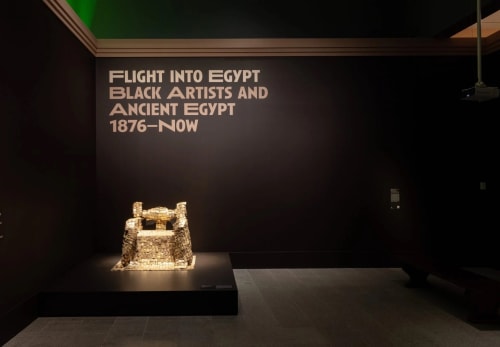In the foyer of the Met’s second-floor gallery, Cleopatra’s Chair sits empty, beckoning. This throne, constructed by legendary sculptor Barbara Chase-Riboud, is a remnant of a sustained revelation. In 1957, at only 18 years old, the American artist visited Egypt and experienced an awakening, this first encounter with artworks beyond the European canon influencing her practice for decades. She recalled of the experience: “For someone exposed only to the Greco-Roman tradition, it was a revelation. I suddenly saw how insular the Western World was vis-a-vis the nonwhite, non-Christian world. The blast of Egyptian culture was irresistible. The sheer magnificence of it. The elegance and perfection, the timelessness, the depth. After that, Greek and Roman Art looked like pastry to me.” She completed Cleopatra’s Chair in 1994 (five years before her own groundbreaking solo exhibition at the Met).
“Flight Into Egypt: Black Artists and Ancient Egypt 1876–Now” highlights almost 200 years of this return-to-self. It’s a meeting ground of Black cultural production, a decidedly pan-African sensibility that engages with ancient Egypt as a spiritual point of reference for fashioning a collective identity; a source for inspiration and a site of affinity against the erasure of a cultural lineage. The exhibition, on view through February 17, 25, offers more than mythos, grounding itself in the promise of great origins reclaimed from a discipline of Egyptology that had categorized the civilization as “proto-European,” separate from the rest of continental Africa. The show’s aims are clear, but our means of flight remain as unresolved as these histories. Egyptian sphinxes don’t have wings.
The Met’s warm walls bear the threads of this restorative practice with a nod of recognition. It’s a noteworthy celebration that feels uncharacteristic—if not unheard of—at this institutional scale. The museum’s commitment to the work feels singular in its candor, an endeavor that imbues the space with an authenticity that is above all else deeply comforting. It’s a feeling only dwarfed by the magnitude of its implications: the way a movement appears before our eyes with resonances that touch the soul.
The survey’s pantheon of Black artists ranges from contemporary titans like David Hammons and Jean-Michel Basquiat to lesser known figures from the 19th century. Together they depict a well of spiritual data, the source material of self. Beyond the visual works, however, the abundance of music and literature underscores the museum’s role as a public resource.
While there are many allusions to ancient architectures and traditions of object-making throughout “Flight,” the curatorial team resisted including any antiquities from the Met’s collection. McClain Groff, the Research Associate for the exhibition, tells me that this noted absence is intentional. “If you want to see those, you can go to the Egyptian wing.”
“Flight into Egypt,” does, however, include the works of living Egyptian artists such as Cairo-born sculptor Iman Issa and feminist polymath Ghada Amer. The “Heritage Studies” on display are more in conversation with each other than they are with any preoccupation with the “ancient.” Maha Maamoun’s Domestic Tourism II is a montage steeped in celluloid fantasy, a compilation of popular cinematic representations of Egypt from the New Hollywood era of the mid-20th century. Mahmoud Mokhtar’s Bride of the Nile rests in the center of a room, a subtle standout among more commanding figurative works. The bronze and silver bust peers over its scarab-encrusted clavicle, as if eavesdropping on the video collage installed behind it. Shepersonifies the collective turning of a head to look back on a past that is never as distant as history may portray. Her earring dangles, frozen in an inertia that is almost audible.
—Journey Streams

